On Friday Planning Democracy published a post (see here) on whether National Planning Framework 4 had made any difference to the degree of protection that is given to nature under Scotland’s planning system as it was supposed to do. This followed an event at the Scottish Parliament, sponsored by Green MSP Ariane Burgess, and the publication of a report (see here) based on research by volunteers into 347 planning applications which were determined by 12 planning authorities between 13th February 2023, the date NPF4 came into force, and 31st December 2023. Those planning authorities included the Cairngorms National Park Authority (CNPA) but not the Loch Lomond and Trossachs National Park Authority (LLTNPA).
The report found that “while the policies [designed to protect nature] were mentioned in planning officers’ reports, indicating that they had noted them as relevant, it was not resulting in quite the transformational change we need to see. We felt there was very much a business-as-usual approach.” The report noted “Biodiversity officers, Ecology officers or Nature Scot were mentioned as consultees in only 12 (3.4%) cases” and made a number of recommendations for improvement.
Planning Democracy is now going to submit evidence about the effectiveness of NPF4 in protecting nature to the Local Government Housing and Planning Committee’s Review of that framework. This is due to be held on 14th May and Planning Democracy is asking the public to submit further examples to info@planningdemocracy.org.uk .
Lorna Slater, the Green MSP should be very interested in this given her welcome statement that:
“We are in the midst of a biodiversity crisis. The facts are beyond doubt: nature is declining
fast. It is estimated that 1 million species across the world are at threat of extinction. Here in
Scotland, nearly half of our species have decreased in abundance and 11 per cent are under
threat of extinction”.
Ms Slater is the Scottish Government Minister responsible for both biodiversity and National Parks, so one might have reasonably expected that the Loch Lomond and Trossachs National Park Authority would have been ahead of the game when it came to applying existing planning policies and those in NPF4 designed to protect nature and would be setting an example to other planning authorities.
While the LLTNPA approach to the Cononish goldmine indicates otherwise (see here), further recent evidence, prompted and informed by work undertaken by Mary Jack, indicates that the LLTNPA are not just failing to use NPF4 to strengthen the protection of nature, they are actually manipulating the planning system to favour development over the protection of nature.
The LLTNPA’s handling of the holiday lodge applications on Inchconnachan
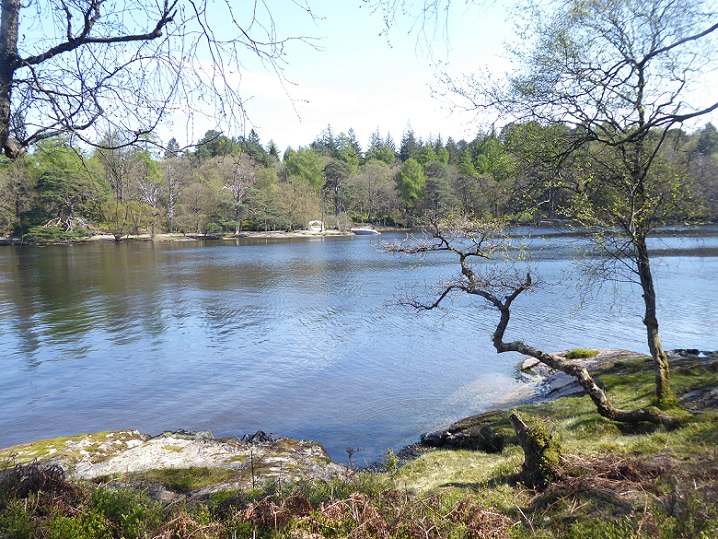
The LLTNPA’s Planning Committee meeting on 18th December (see here for papers ) approved the application by Mr and Mrs Jones (Kirsty Young and her husband) to build a new luxury holiday lodge and boathouse on Inchconnachan, the island on Loch Lomond which is protected as a Special Area of Conservation and famous for its wallabies. Whether this decision, as Geoff Riddington has recently shown (see here), is compatible with the continued presence of wallabies and fallow deer on the island is unclear. The interesting point, however, in terms of how the planning system in the National Park is being operated to protect nature is how planning officers paved the way legally to allow LLTNPA Board Members to take this decision.
As previously explained on Parkswatch (see here), there had been a lodge out of sight near the centre of the island. This had been in a ruinous state for many years and in 2012 the LLTNPA had granted Luss Estates, the former owners of the island, planning permission to demolish the existing buildings and replace them. Mr and Mrs Jones bought the island, however, with a view to building a new more luxurious lodge in a much more prominent position on a “greenfield site” on the north shore of the island.
Under LLTNPA’s policies such a lodge should never have been entertained because it would resulted in the loss of part of qualifying (undeveloped part) Special Area of Conservation – the Woodland Trust objected to the application for this very reason – and because their Visitor Experience policy contained a general policy presumption against new small scale developments, including luxury holiday lodges, in the countryside.
The LLTNPA’s Visitor Experience policy did, however, allow upgrading to existing developments and that is the loophole the planners exploited to allow them to recommend this development.
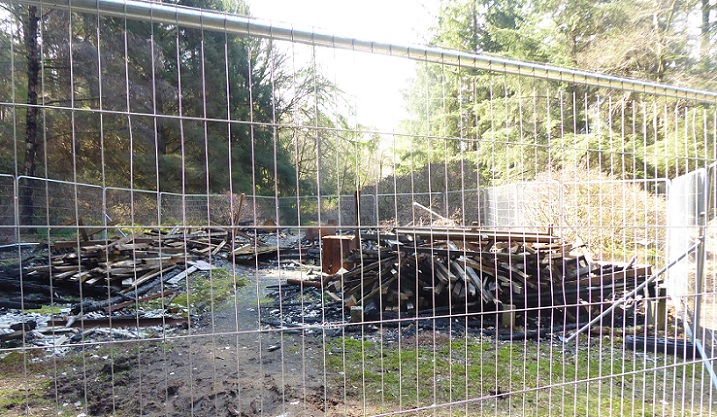
The remains of the old lodge had mysteriously burned down at the end of May 2022 (see here) – as far as I am aware responsibility for this has never been ascertained – leaving the island “development free”. However, the planning permission to develop the “brownfield” site on which is was located was still extant. The 2012 Planning Application was never acted on but was renewed by a new application (2018/0011/DET see here) in December 2018 which required the development to be initiated within 3 years, i.e. by December 2021 six months before the old lodge burned down.

In the intervening period, however, Covid had struck and the Scottish Government twice used the emergency Coronavirus legislation to extend the deadline for all planning applications whose permissions were due to expire, on the second occasion to 31st March 2023.
On 31st March 2023, Mr and Mrs Jones apparently submitted a new application (2023/0118/LAW – see here) asking the LLTNPA to confirm that development 2018/0011/DET, to demolish and replace the old lodge, had been initiated by the new legal deadline. Strangely there is no mention of the application in the weekly planning lists the LLTNPA published for the week commencing 27th March (which contains another planning application dated 31st March) or 3rd April. The application was first mentioned on the list for the w/c 10th April:
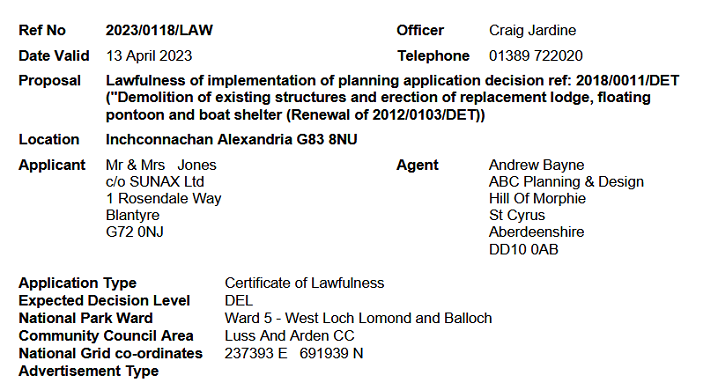
The officer’s Delegated Report is dated 24th April and it was determined on 2nd May so the public had at most two weeks to be made aware of the application and comment on it before it was decided. It would have been of considerable interest to those who had objected to the application to build the new lodge on an undeveloped part of the Special Area of Conservation.
Almost all the documents relating to application 2023/0118/LAW have disappeared from the planning portal but you can still read the Delegated Officers report. This states “the Notification of Intention to Develop form was submitted on 8 March 2023″ and “it is confirmed that the relevant pre-commencement elements of the planning conditions of the planning permission (namely, Conditions 4,5,8 and 10) were indeed discharged by the Planning Authority on 13 March 2023″. None of these supporting documents (which relate to the protection of bats, woodland, the SAC’s “qualifying features and habitats” and the design of the replacement lodge) can be found on the planning portal for 2018/0011/DET. The LLTNPA’s usual practice is to publish such documents (except the notices stating a development has been initiated) once received.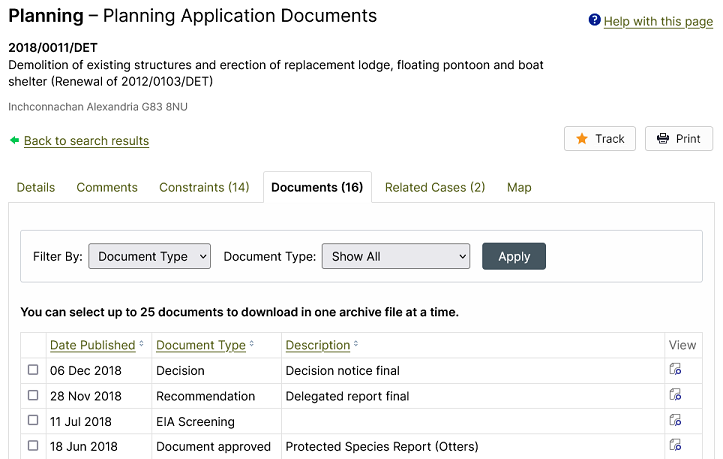
Perhaps the documents have been removed?
The officers report for 2023/0118/LAW goes on to conclude:
“The available evidence demonstrates that material operations, as defined by section 27(4) of the
Town and Country Planning (Scotland) Act 1997, comprising the demolition of existing buildings
had been carried out on the site prior to the expiry of the planning permission 2018/0011/DET. On
the basis of the evidence provided it can be concluded that the material operations took place prior
to the expiry of the planning permission, and it therefore remains extant.”
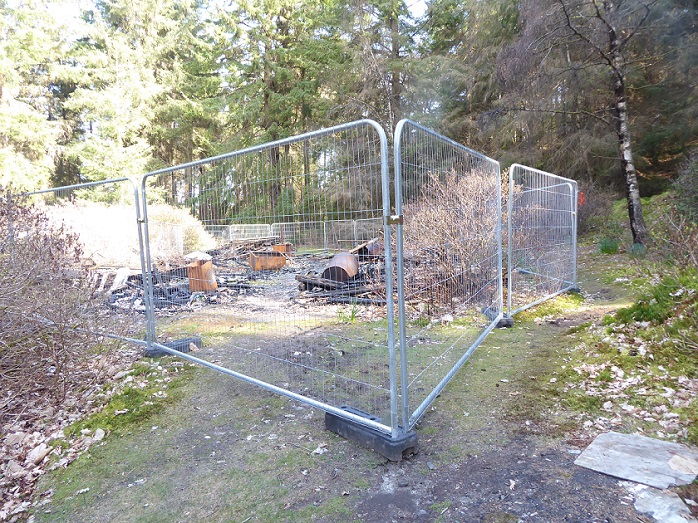
The evidence from a year later (photos above) shows that there appear to have been some limited actions following the fire, with the remains being piled up and surrounded by heras fencing. I have to say that what shocked me was that in a year Mr and Mrs Jones had done so little to clear up the mess. Whether this should count as initiation of the development is a moot point.
The Delegated Officers report 2023/0118/LAW refers to Paragraph 19 of Annex F to Scottish Government Circular 10/2009 to say that for a development to have been lawfully initiated this only needs to be on the “balance of probability”, not “beyond reasonable doubt”, and uses this to justify their conclusion. The Report fails to mention Planning Circular 2022/03 (see here) which has a section on initiation of developments. This states:
“A person who intends to start development that has been granted planning permission (including planning permission in principle) must, once they have decided the date they will start work, inform the planning authority of that date as soon as is practicable and before starting work. There is no minimum period of notice.”
Given that by the LLTNPA officers’ own account the notice of initiation of development was submitted on 8th March 2023, for the development to have been lawful, Mr and Mrs Jones or their agents would have had to have undertaken work between then and 31st March. The LLTNPA’s report provides no evidence to substantiate this and there was certainly no sign of ongoing work, as one might expect, when I visited at the end of April.
Had work been undertaken, it would have been contrary to the advice provided by LLTNPA in its “Appropriate Assessment” on the application for the new lodge (2021/0452/DET – page 98-99 of the Committee Report):
“There will be no adverse effect on the integrity of the SPA [Special Protection Area for Birds] if the following mitigation measures are implemented:
•There will be no work carried out during the bird breeding season March – August inclusive (as a precautionary approach) ;……………….”
None of this is to deny that Mr and Mrs Young did some clear up work after the fire but, while this may have been necessary and lawful from a duty of care perspective, it could and should not under Scottish Government guidance have been allowed to count as their having initiated the development. It was a response to external events.
Moreover, Mr and Mrs Young’s proposal to build a new lodge (2021/0452/DET- see here) included proposals to demolish the old lodge and associated buildings. This was scheduled as part of Stage 2 of their plans to construct the new lodge. There would have been no need to do this had Mr and Mrs Young intended to proceed with the old planning applications from Luss Estates. Indeed, they could have used 2018/0011/DET to clear up the mess on the island but had made no moves to do so despite the extensions granted by the Coronavirus legislation.
That Mr and Mrs Young originally had no intention of implementing 2018/0011/DET is also confirmed by information from the Habitats Regulations Assessment on page 85 of the report presented to the LLTNPA’s planning Committee in December 2023:

Whoops!
The LLTNPA’s justification for approving the new luxury lodge
The Certificate of Lawfulness issued in May 2023 was crucial for enabling LLTNPA to argue to their Planning Committee in December that planning permission already existed for NEW tourism accommodation on Inchconnachan. This then enabled them to recommend giving the go-ahead to a new lodge in a different location contrary to the LLTNPA’s policies designed to protect nature:
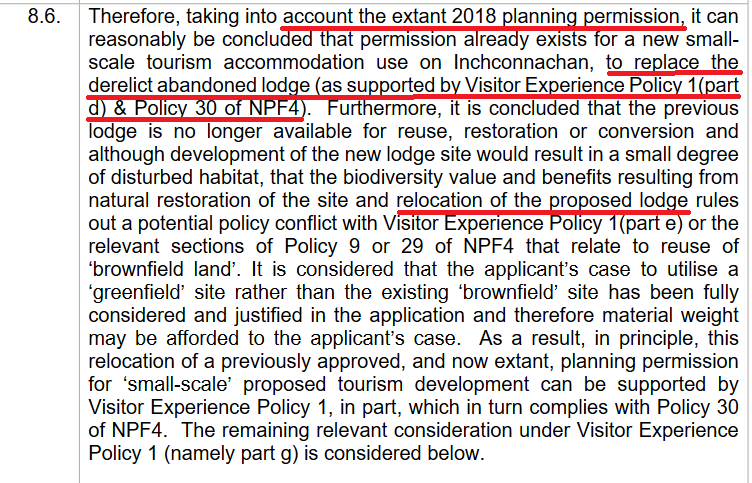
In truth on the balance of probabilities there was no lawful development to be “relocated”.
Had the planning permission for the old application expired, the LLTNPA would have had little choice but to refuse the new application under its Visitor Experience policies because under its planning policies the island would have counted as being free of tourist developments.
The LLTNPA also used the “extant” planning permission to circumvent Policy 30 on tourist development in NPF4. This states:
“Development proposals for new or extended tourist facilities or accommodation, including caravan and camping sites, in locations identified in the LDP, will be supported.”
Since there is nothing in the LLTNPA’s LDP identifying Inchconnachan as a suitable location for tourism development, the presumption should have been against any development on the island. But the LLTNPA was able to disregard this NPF4 policy on the grounds that a development was already underway.
Having issued the Certificate of Lawful Development, which enabled it to circumvent planning policies on new tourism developments, the LLTNPA were faced with the possibility that the applicants might be able to build two lodges not one! Hence condition 2 in the draft Heads of Terms Agreement included in the Planning consent for the new lodge which revokes planning permission 2018/0011/DET:
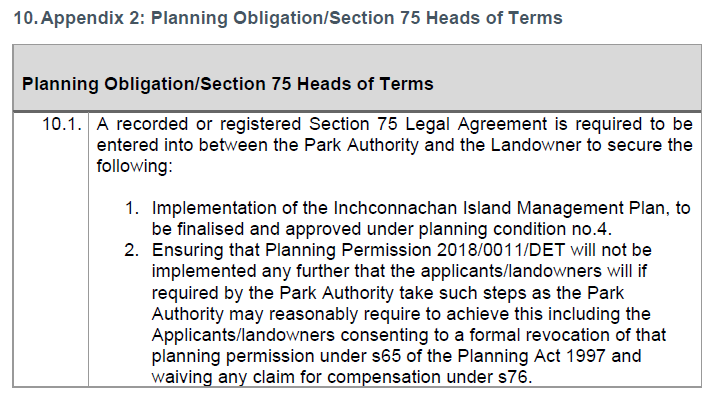 What a merry-go-round!
What a merry-go-round!
It is not known the degree to which the last minute decision by those acting on behalf of Mr and Mrs Jones to seek a declaration that the lodge development had been initiated was prompted by LLTNPA Planning Staff. All the evidence, however, suggests that the developers had not had any intention of proceeding with 2018/0011 until it was about to expire. The explanation for the about turn may lie in the letter from NatureScot dated 27 January 2023. This “did not support the National Park in their conclusion that there would not be an adverse effect on the integrity of the Loch Lomond Woods SAC”. That letter threatened to pull the rug out from the application to build a new lodge – hence the importance of showing that there was already a development underway.
Once LLTNPA planners had formally declared there was an extant development on the island, it was only a matter of showing that the new lodge would not be that damaging to the SAC and could bring new benefits for nature for the application to be justifiable under their own planning policies and NPF4.
Hence why the Appropriate Assessment in the Committee report emphasises that the new lodge would only affect a very small proportion, 0.009%, of the Special Area of Conservation. Since Inchconnachan is only part of the SAC, the percentage of the island which will be impacted on by the development is higher than this. More importantly, however, the LLTNPA ignored the ecological significance of islands for protecting nature. The reason, for example, why capercaillie survived so long in the Loch Lomond area, long after they had become extinct elsewhere in the south of Scotland, was precisely because they lived on the islands. That also helps explain why the wallaby are still to be found on Inchconnachan.
Potentially the Loch Lomond Islands could form refuges for nature in a way that other mainland parts of the Loch Lomond SAC could not. The LLTNPA failed to consider this point properly and there is nothing in the planning conditions, for example, to prevent visitors to the new luxury lodge bringing their canine friends (even though the report refers to the impacts of dogs on wildlife).
It was, however, another loosely worded policy in NPF4 which allowed the LLTNPA to give the development the final go-ahead:
“Development proposals that are likely to have a significant effect on an existing or proposed European site (Special Area of Conservation or Special Protection Areas) and are not directly connected with or necessary to their conservation management are required to be subject to an “appropriate assessment” of the implications for the conservation objectives.” (Policy 4b).
The LLTNPA used this (and their own policies) to argue that by consenting to the proposed luxury lodge they could bring conservation benefits to Inchconnachan that might not otherwise happen:
“It is recognised generally that the delivery of land management by a landowner is desirable but largely undertaken on a voluntary basis. However, in this instance, with the benefit of a planning permission (if approved by Members) a finalised version of the Island Management Plan can be agreed by planning condition and a Planning Obligation (Section 75 Agreement) can be utilised as the mechanism to secure, agree and monitor the delivery of the plan. This agreement would become an obligation on the land title of the island, and in perpetuity. The applicant has informally agreed to these terms”
In other words the cost of restoring nature on Inchconnachan is to allow the new luxury lodge to go ahead. I will come back to the island management plan in due course – at present it appears to promise little more investment than payment for a “warden” – but Mr and Mrs Jones’ management of the island to date inspires little confidence that they will put conservation first. They have had two years to clear up the mess of previous developments, remove some of the non-native trees on the islands etc etc. but appear to have done little or nothing.
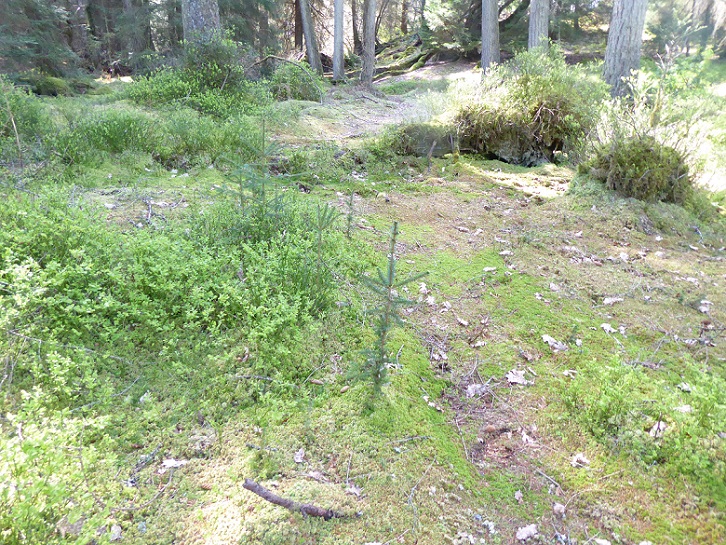
The LLTNPA’s planning consent allows the developer to delay the removal of non-native plants and trees until AFTER the new lodge has been built.
Discussion
The evidence I have considered here supports Planning Democracy’s conclusion that it has been “business as usual” in the LLTNPA since NPF4 came into force. I would go further and am happy to state that what the LLTNPA did to get the luxury new lodge on Inchconnachan approved would disgrace any planning authority.
Had LLTNPA senior management given as much importance to protecting nature as enabling developments to go ahead, they could have easily taken a far more critical look at whether there was in fact any lawful development on Inchconnachan (2023/0118/LAW). For example, they could have sought evidence from the many campers and day visitors who go to the island as to whether work did actually take place in March 2023. They chose not to do so but instead rushed through their decision keeping it as secret as possible.
The legal position in Scotland, that once a development is judged to have been initiated it is there for all time and that “the principle of development has been established”, creates a huge loophole for developers and planners: all they need to do – and who is to say Mr and Mrs Jones did not do this? – is to dig up one clod of earth and the development can be said to have been initiated. Unless that loophole is closed, NPF4 is never going to protect nature from lots of damaging developments that were consented under previous planning frameworks.
The wider issue, however, is that senior staff and board members in the LLTNPA are infused with neo-liberal ideology that maintains the only way to address the nature emergency in Scotland lies in persuading rich and powerful private interests to invest in nature. This then creates a planning paradox: that the only way to protect nature under the planning system is to allow new developments that destroy parts of it to go ahead. That view is clearly articulated in the LLTNPA Committee Report.
In my view the idea that a Section 75 Agreement will be able to secure conservation benefits, in this case the conservation management of Inchconnachan in perpetuity, is entirely fanciful. What would happen, for example, if the new lodge were to burn down at some point in future and Mr and Mrs Jones or their successors was to have no source of income to pay for management of the island. We will see!
An alternative and much better way to secure conservation management would be through Land Reform. If, for example all prospective purchasers of designated sites had to demonstrate their commitment to conservation management and commit to land management plan prior to being allowed to buy land, there would be absolutely no need for developments like Mr and Mrs Jones’ luxury lodge. With the evidence showing rich people, with a few notable exceptions, are prepared to invest very little of their own money in conservation, it is likely that the price of such land would fall. This would enable local communities, or indeed public bodies like National Park Authorities, to buy the land and manage it in the public interest.
The LLTNPA’s whole approach to planning still puts development before the protection of nature – hence why the Flamingo Land proposals are still on the table. This provides a very strong argument as to why Lorna Slater, as the Minister responsible, needs to sort out our existing National Parks before she creates any new ones.
The obfuscation, delay, and lengthy prevarication within the application ‘process’ , which has led to this situation on the LLTNP Island, points up the myriad weaknesses in planning everywhere across Scotland
Where regional authorities have become so ring-fenced by conflicting intentions, and yet are put in a position of being both judge and jury to their own desire to drive tax revenues ever higher, all sorts of new developments will escape proper scrutiny and sanction.
One new 5 bedroom designer development, within ancient woodland on the boundary of SSSI near here, could not have occurred for many good reasons. Yet, a seasonal watercourse through the site was ignored, omitted from all site plans, quite deliberately -dismissed. The concerns of a neighbouring property down hill were equally cynically dismissed. Then screeds of paperwork concerning specific promises of mitigation through future replanting were submitted. Indeed, eventually so much detail in hundreds of documents were submitted, this eventually overwhelmed the ability of any planning highland region evaluation team to gainsay the application.
Of course the truth remains that no house of that scale should ever be needed there. The project is unjustifiable, in such a remote place. Access to the site is very poor, (along a weak, single track ..widened ‘cart track’) Locally, mains services for water and the power network are at full capacity and so on. All this becomes insignificant in the face of a “millionaires” dream. Once the decision system is inundated, under vast pressure from established ecological ‘consultants’, the safeguards and regulation ‘buckle’ .No matter the cost …… all possible regulatory boxes will be responded to. The retained ‘experts’ will ensure all possible angles for objection are out manoeuvred and summarily defeated.
Such is the case when ‘Big money’ plays the game with a rural community, through the current highland planning process.
Those ancient Trees are already ripped away now, excavators are today removing peaty ground, and busy rockpecking a platform across another virgin hillside. Just as nesting birds arrive to find their summertime home..gone.
Firstly, although it predates the NPF4, there are many parallels that could be drawn with the way the LLTNPA steered the Tom Hunter application at Ross Priory through similar regulations. Thankfully, a neighbour’s reading of the laws around EIAs ultimately tripped up the wealthy individual’s application, not the planning authority.
Second, the discussion above states: « The wider issue, however, is that senior staff and board members in the LLTNPA are infused with neo-liberal ideology that maintains the only way to address the nature emergency in Scotland lies in persuading rich and powerful private interests to invest in nature. This then creates a planning paradox: that the only way to protect nature under the planning system is to allow new developments that destroy parts of it to go ahead. That view is clearly articulated in the LLTNPA Committee Report. » This applies to The RSPB as much as private interests, judging by the commercial, tourism led approach to their activities at the Endrick Mouth since 2012.
Is anyone who knows how these things are done in Scotland even remotely surprised by any of this?
The next question is how far the curtilage of this dwelling will extend? Public figure, safety and privacy…
I totally endorse Peter’s view that there are many parallels to be drawn between the Tom Hunter application at Ross Priory and that for Inchconnachan. In both cases it became abundantly clear throughout both Planning & Access Committee meetings that APPROVE would be the outcome.